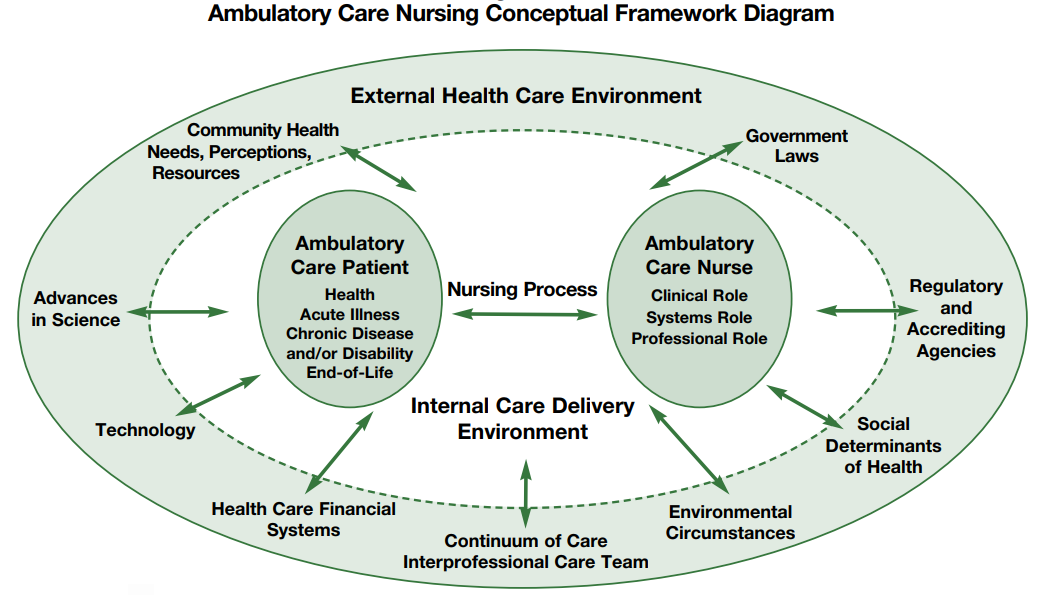Ambulatory Care Nursing Conceptual Framework Diagram
The profession of ambulatory care nursing and how care is delivered has grown and evolved over time, and with it, the conceptual framework, or blueprint, of ambulatory care nursing practice has also evolved. Conceptual frameworks identify the major concepts and their relationships in an area of practice.
The American Academy of Ambulatory Care Nursing (AAACN) formed an expert member task force in 1998 to develop the first ambulatory care conceptual model. The group identified major areas of practice, knowledge, and skills, and delineated how they were related to each other and the ambulatory care nursing role (Haas, 2001). A diagram was created to depict the concepts and relationship between them.
A second task force in 2009 reviewed the original conceptual model and revised it. The second version retained the original concept of nurse, expanded the concept of patient, and proposed adding the concept of environment to the model. The revised draft model was shared with AAACN members for comment. Members provided many suggestions and comments that were incorporated into the revised framework statement (Mastal, 2010).
During the revision of the Scope and Standards of Practice for Professional Telehealth Nursing, 6th Edition, it was noted that significant environmental changes that affected the practice of ambulatory care nursing had occurred, including advances in health sciences, and growth of healthcare technologies, healthcare systems, types of outpatient organizations, and environmental factors affecting patient health and health care (Mastal, 2018). The Ambulatory Care Nursing Conceptual Framework Diagram was updated delete extra space to include the changes in the three concepts of nurse, patient, and environment.

In 2023, the task force revising the Scope and Standards of Practice for Professional Ambulatory Care Nursing, 10th edition, enhanced the continuum by refining the conceptual model. Updates included adding shading gradients to the circles within the internal environment and introducing a contrasting color to the external environment sphere. These changes were designed to clearly differentiate these areas, making their distinct dimensions easier for readers to understand.
References
- American Academy of Ambulatory Care Nursing (AAACN). (2023). Scope and standards of practice for
- professional ambulatory care nursing. Pitman, NJ: Author.
- American Academy of Ambulatory Care Nursing (AAACN). (2018). Scope and standards of practice of professional telehealth nursing. Pitman NJ: Author.
- Haas, S.A. (2001). Ambulatory care specialty nursing practice. In J. Robinson (Ed.), Core curriculum for ambulatory care nursing (1st ed., pp. 4-7). Philadelphia, PA: W.B. Saunders Co.
- Mastal, M.F. (2010). Ambulatory care nursing: Growth as a professional specialty. Nursing Economic$, 28(4), 267-269, 275.
- Mastal, M.F. (2018). Evolution of a conceptual model: Ambulatory care nursing. Nursing Economic$, 36(6), 296-300, 303.
